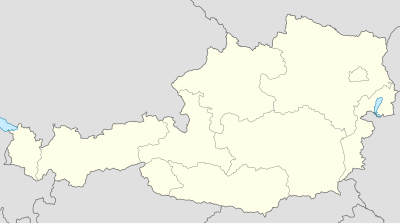Austria
Republic of Austria Republik Österreich (German) | |
|---|---|
| Anthem: "Bundeshymne der Republik Österreich" "National Anthem of the Republic of Austria" | |
| Religion (2021)[4] |
|
| Demonym(s) | Austrian |
| Government | Federal semi-presidential republic[5][d] |
| Alexander Van der Bellen | |
| Karl Nehammer | |
| Legislature | Parliament |
| Federal Council | |
| National Council | |
| Formation | |
• Name | 1 November 996 |
• Duchy | 17 September 1156 |
| 6 January 1453 | |
• Empire | 11 August 1804 |
| 30 March 1867 | |
| 12 November 1918 | |
| 10 September 1919 | |
| 1 May 1934 | |
| 13 March 1938 | |
| 27 April 1945 | |
| 27 July 1955 | |
• Joined the European Union | 1 January 1995 |
| Area | |
• Total | 83,879[6] km2 (32,386 sq mi) (113th) |
• Water (%) | 0.84 (2015)[7] |
| Population | |
• April 2022 estimate | |
• Density | 107.6/km2 (278.7/sq mi) (106th) |
| GDP (PPP) | 2024 estimate |
• Total | |
• Per capita | |
| GDP (nominal) | 2024 estimate |
• Total | |
• Per capita | |
| Gini (2021) | low |
| HDI (2022) | very high (22nd) |
| Currency | Euro (€) (EUR) |
| Time zone | UTC+1 (CET) |
• Summer (DST) | UTC+2 (CEST) |
| Date format | dd/mm/yyyy |
| Driving side | right |
| Calling code | +43 |
| ISO 3166 code | AT |
| Internet TLD | .at |
Austria,
Austria emerged from the remnants of the Eastern and Hungarian March at the end of the first millennium. Originally a margraviate of Bavaria, it developed into a duchy of the Holy Roman Empire in 1156 and was later made an archduchy in 1453. In the 16th century, Vienna began serving as the empire's administrative capital and Austria thus became the heartland of the Habsburg monarchy. Before the dissolution of the Holy Roman Empire two years later, in 1804, Austria established its own empire, which became a great power and the dominant member of the German Confederation. The empire's defeat in the Austro-Prussian War of 1866 led to the end of the Confederation and paved the way for the establishment of Austria-Hungary a year later. Austria was the common name for the non-Hungarian parts of the state, also known as Cisleithania.
After the assassination of Archduke Franz Ferdinand in 1914, Emperor Franz Joseph declared war on Serbia, which ultimately escalated into World War I. The empire's defeat and subsequent collapse led to the proclamation of the Republic of German-Austria in 1918 and the First Austrian Republic in 1919. During the interwar period, anti-parliamentarian sentiments culminated in the formation of an Austrofascist dictatorship under Engelbert Dollfuss in 1934. A year before the outbreak of World War II, Austria was annexed into Nazi Germany by Adolf Hitler, and it became a sub-national division. After its liberation in 1945 and a decade of Allied occupation, the country regained its sovereignty and declared its perpetual neutrality in 1955.
Austria is a
Austria has been a member of the
Etymology
The native name for Austria, Österreich, derives from the
Austria was a prefecture of Bavaria created in 976. The word "Austria" is a Latinisation of the German name and was first recorded in the 12th century.[22] At the time, the Danube basin of Austria (Upper and Lower Austria) was the easternmost extent of Bavaria.
History
The Central European land that is now Austria was settled in pre-Roman times by various
Middle Ages
After the fall of the Roman Empire, the area was invaded by
The first record showing the name Austria is from 996, where it is written as
As a result,
In the 14th and 15th centuries, the
The Habsburgs began also to accumulate territory far from the hereditary lands. In 1477, Archduke
In 1526, following the
17th and 18th centuries

During the long reign of Leopold I, Holy Roman Emperor following the successful defence of Vienna against the Turks in 1683, under the command of the King of Poland John III Sobieski,[33] the Great Turkish War resulted in most of Hungary being controlled by Austria. This arrangement was formalized in the Treaty of Karlowitz in 1699.
Emperor
From that time, Austria became the birthplace of classical music and played host to different composers including Joseph Haydn, Wolfgang Amadeus Mozart, Ludwig van Beethoven, and Franz Schubert.
19th century
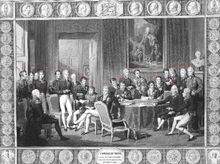
Austria later became engaged in a war with
It emerged from the
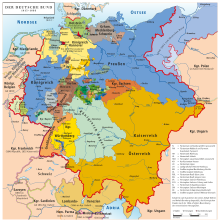
The various different possibilities for a united Germany were: a
After the defeated Hungarian Revolution of 1848, the Austro-Hungarian Compromise of 1867, the Ausgleich, provided for a dual sovereignty, the Austrian Empire and the Kingdom of Hungary, under Franz Joseph I.[39] The Austrian-Hungarian rule of this diverse empire included various groups, including Germans, Hungarians, Croats, Czechs, Poles, Rusyns, Serbs, Slovaks, Slovenes, and Ukrainians, as well as large Italian and Romanian communities.
As a result, ruling Austria-Hungary became increasingly difficult in an age of emerging nationalist movements, requiring considerable reliance on an expanded secret police. Yet, the government of Austria tried its best to be accommodating in some respects: for example, the Reichsgesetzblatt, publishing the laws and ordinances of Cisleithania, was issued in eight languages; and all national groups were entitled to schools in their own language and to the use of their mother tongue at state offices.

Many Austrians of all different social circles such as Georg Ritter von Schönerer promoted strong pan-Germanism in hope of reinforcing an ethnic German identity and the annexation of Austria to Germany.[40] Some Austrians such as Karl Lueger also used pan-Germanism as a form of populism to further their own political goals. Although Bismarck's policies excluded Austria and the German Austrians from Germany, many Austrian pan-Germans idolised him and wore blue cornflowers, known to be the favourite flower of German Emperor William I, in their buttonholes, along with cockades in the German national colours (black, red, and yellow), although they were both temporarily banned in Austrian schools, as a way to show discontent towards the multi-ethnic empire.[41]
Austria's exclusion from Germany caused many Austrians a problem with their national identity and prompted the Social Democratic Leader Otto Bauer to state that it was "the conflict between our Austrian and German character".[42] The Austro-Hungarian Empire caused ethnic tension between the German Austrians and the other ethnic groups. Many Austrians, especially those involved with the pan-German movements, desired a reinforcement of an ethnic German identity and hoped that the empire would collapse, which would allow an annexation of Austria by Germany.[43]
A lot of Austrian pan-German nationalists protested passionately against minister-president
Early 20th century
As the
On 21 October 1918 the elected German members of the Reichsrat (parliament of Imperial Austria) met in Vienna as the Provisional National Assembly for German Austria (Provisorische Nationalversammlung für Deutschösterreich). On 30 October the assembly founded the Republic of German-Austria by appointing a government, called Staatsrat. This new government was invited by the Emperor to take part in the decision on the planned armistice with Italy, but refrained from this business.[48]
This left the responsibility for the end of the war, on 3 November 1918, solely to the emperor and his government. On 11 November, the emperor, advised by ministers of the old and the new governments, declared he would not take part in state business any more; on 12 November, German-Austria, by law, declared itself to be a democratic republic and part of the new German republic. The constitution, renaming the Staatsrat as Bundesregierung (federal government) and Nationalversammlung as Nationalrat (national council) was passed on 10 November 1920.[49]
The
Over three million German-speaking Austrians found themselves living outside the new Austrian Republic as minorities in the newly formed or enlarged states of
The border between Austria and the
Interwar period and World War II
After the war, inflation began to devalue the Krone, which was still Austria's currency. In autumn 1922, Austria was granted an international loan supervised by the League of Nations.[61] The purpose of the loan was to avert bankruptcy, stabilise the currency, and improve Austria's general economic condition. The loan meant that Austria passed from an independent state to the control exercised by the League of Nations. In 1925, the Austrian schilling was introduced, replacing the Krone at a rate of 10,000:1. Later, it was nicknamed the "Alpine dollar" due to its stability. From 1925 to 1929 the economy enjoyed a short high before nearly crashing after Black Tuesday.
The
In February 1934, several members of the Schutzbund were executed,

His successor Kurt Schuschnigg acknowledged the fact that Austria was a "German state" and he also believed that Austrians were "better Germans" but he wished that Austria would remain independent.[69] He announced a referendum on 9 March 1938, to be held on 13 March, concerning Austria's independence from Germany.
Nazi rule
On 12 March 1938, Austrian Nazis took over the government, while German troops occupied the country, which prevented Schuschnigg's referendum from taking place.[70] On 13 March 1938, the Anschluss (lit. 'joining' or 'connection') of Austria was officially declared. Two days later, Austrian-born Adolf Hitler announced what he called the "reunification" of his home country with the "rest of the German Reich" on Vienna's Heldenplatz. He established a referendum which confirmed the union with Germany in April 1938.
Parliamentary elections were held in Germany (including recently annexed Austria) on 10 April 1938. They were the final elections to the Reichstag during Nazi rule, and they took the form of a single-question referendum asking whether voters approved of a single Nazi-party list for the 813-member Reichstag, as well as the recent annexation of Austria (the Anschluss). Jews, Roma and Sinti were not allowed to vote.[71] Turnout in the election was officially 99.5 percent, with 98.9 percent voting "yes". In the case of Austria, Adolf Hitler's native soil, 99.71 percent of an electorate of 4,484,475 officially went to the ballots, with a positive tally of 99.73 percent.[72] Although most Austrians favored the Anschluss, in certain parts of Austria, the German soldiers were not always welcomed with flowers and joy, especially in Vienna, which had Austria's largest Jewish population.[73] Nevertheless, despite the propaganda and the manipulation and rigging which surrounded the ballot box result, there was massive genuine support for Hitler for fulfilling the Anschluss,[74] since many Germans from both Austria and Germany saw it as completing the long overdue unification of all Germans into one state.[75]
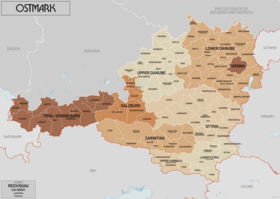
On 13 March 1938, Austria was annexed by the
Though Austrians made up only 8 percent of the population of the Third Reich,
Most of the resistance groups were soon crushed by the Gestapo. While the plans of the group around Karl Burian to blow up the Gestapo's headquarters in Vienna were uncovered,[90] the important group around the later executed priest Heinrich Maier managed to contact the Allies. This so-called Maier-Messner group was able to send the Allies information about armaments factories where V-1 flying bombs, V-2 rockets, Tiger tanks and aircraft (Messerschmitt Bf 109, Messerschmitt Me 163 Komet, etc.) were manufactured, information which was important to the success of Operation Crossbow and Operation Hydra, both of which were preliminary missions before the launch of Operation Overlord. This resistance group, which was in contact with the American secret service (OSS), soon provided information about mass executions and concentration camps such as Auschwitz. The group's aim was to cause Nazi Germany to lose the war as quickly as possible and re-establish an independent Austria.[91][92][93]
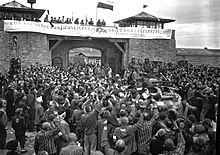
Allied occupation
Vienna fell on 13 April 1945, during the Soviet Vienna offensive, just before the total collapse of the Third Reich. The invading Allied powers, in particular the Americans, planned for the supposed "Alpine Fortress Operation" of a national redoubt, that was largely to have taken place on Austrian soil in the mountains of the Eastern Alps. However, it never materialised because of the rapid collapse of the Reich.
The Austrian government, consisting of Social Democrats, Conservatives, and Communists resided in Vienna, which was surrounded by the Soviet zone. This Austrian government was recognised by the allies of World War II in October 1945 after concerns that Karl Renner could be Stalin's puppet.[98] On 26 July 1946 the Austrian Parliament passed its first nationalization law and approximately 70 mining and manufacturing companies were seized by the Austrian state. The Ministry of Property Protection and Economic Planning (Ministerium für Vermögenssicherung und Wirtschaftsplanung) was responsible for directing the nationalized industries under the directorship of Minister Peter Krauland (party ÖVP).[99]
Independence
On 15 May 1955, after talks which lasted for years and were influenced by the
The status of Tyrol is a lingering problem between Austria and Italy. To this day, there are 20 different squares in Austrian cities called "Südtiroler Platz" (South Tyrolean Square) in memory of the supposed loss of the Austrian territories. Riots by the South Tyrolean independence movement have been documented in the 1950s and 1960s. A great degree of autonomy was granted to Tyrol by the Italian national government.
The political system of the
Since 1945, governing via a single-party government has occurred twice: 1966–1970 (ÖVP) and 1970-1983 (SPÖ). During all other legislative periods, either a grand coalition of SPÖ and ÖVP or a "small coalition" (one of these two and a smaller party) ruled the country.
Following a referendum in 1994, at which consent reached a majority of two-thirds, the country became a member of the European Union on 1 January 1995.[105]
The major parties SPÖ and ÖVP have contrary opinions about the future status of Austria's military nonalignment: While the SPÖ in public supports a neutral role, the ÖVP argues for stronger integration into the EU's security policy; even a future NATO membership is not ruled out by some ÖVP politicians (ex. Werner Fasslabend (ÖVP) in 1997).[citation needed] In reality, Austria is taking part in the EU's Common Foreign and Security Policy, participates in peacekeeping and peace creating tasks, and has become a member of NATO's "Partnership for Peace"; the constitution has been amended accordingly.[106] Since Liechtenstein joined the Schengen Area in 2011, none of Austria's neighbouring countries performs border controls towards it anymore.[107]
Government and politics
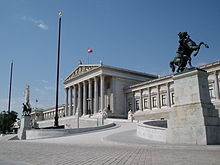
The
The president of Austria is the head of state. The president is directly elected by popular majority vote, with a run-off between the top-scoring candidates if necessary. The chancellor of Austria is head of the government. The chancellor is selected by the president and tasked with forming a government based on the partisan composition of the lower house of parliament.
The government can be removed from office by either a presidential decree or by
Austria's parliament consists of two chambers. The composition of the Nationalrat (183 seats) is determined every five years (or whenever the Nationalrat has been dissolved by the federal president on a motion by the federal chancellor, or by Nationalrat itself) by a general election in which every citizen over the age of 16 has the right to vote. The voting age was lowered from 18 in 2007.[110]
While there is a general threshold of 4% of the vote for all parties in federal elections (Nationalratswahlen) to participate in the proportional allocation of seats, there remains the possibility of being elected to a seat directly in one of the 43 regional electoral districts (Direktmandat).
The Nationalrat is the dominant chamber in the legislative process in Austria. However, the upper house of parliament, the
While the bicameral Parliament and the Government constitute the legislative and executive branches, respectively, the courts are the third branch of Austrian state powers. The Constitutional Court (Verfassungsgerichtshof) exerts considerable influence on the political system because of its power to invalidate legislation and ordinances that are not in compliance with the constitution. Since 1995, the European Court of Justice may overrule Austrian decisions in all matters defined in laws of the European Union. Austria also implements the decisions of the European Court of Human Rights, since the European Convention on Human Rights is part of the Austrian constitution.
Since 2006

After general elections held in October 2006, the Social Democratic Party (SPÖ) emerged as the strongest party, and the Austrian People's Party (ÖVP) came in second, having lost about 8 percent of its previous polling.[112][113] Political realities prohibited any of the two major parties from forming a coalition with smaller parties. In January 2007 the People's Party and SPÖ formed a grand coalition with the social democrat Alfred Gusenbauer as Chancellor. This coalition broke up in June 2008.
Elections in September 2008 further weakened both major parties (SPÖ and ÖVP) but together they still held 70 percent of the votes, with the Social Democrats holding slightly more than the other party. They formed a coalition with Werner Faymann from the Social Democrats as Chancellor. The Green Party came in third with 11 percent of the vote. The FPÖ and the deceased Jörg Haider's new party Alliance for the Future of Austria, both on the political right, were strengthened during the election but taken together received less than 20 percent of the vote. On 11 October 2008, Jörg Haider died in a car accident.[114]
In the legislative elections of 2013, the Social Democratic Party received 27 percent of the vote and 52 seats; People's Party 24 percent and 47 seats, thus controlling together the majority of the seats. The Freedom Party received 40 seats and 21 percent of the votes, while the Greens received 12 percent and 24 seats. Two new parties, Stronach and the NEOS, received less than 10 percent of the vote, and 11 and nine seats respectively.[115]
On 17 May 2016, Christian Kern from Social Democrats (SPÖ) was sworn in as new chancellor. He continued governing in a "grand coalition" with the conservative People's Party (ÖVP). He took the office after former chancellor, also from SPÖ, Werner Faymann's resignation.[116]
On 26 January 2017, Alexander Van der Bellen was sworn in as the mostly ceremonial – but symbolically significant – role of Austrian president.[117]
After the Grand Coalition broke in Spring 2017 a snap election was proclaimed for October 2017. The Austrian People's Party (ÖVP) with its new young leader Sebastian Kurz emerged as the largest party in the National Council, winning 31.5 percent of votes and 62 of the 183 seats. The Social Democratic Party (SPÖ) finished second with 52 seats and 26.9 percent votes, slightly ahead of the Freedom Party of Austria (FPÖ), which received 51 seats and 26 percent. NEOS finished fourth with 10 seats (5.3 percent of votes), and PILZ (which split from the Green Party at the start of the campaign) entered parliament for the first time and came in fifth place with 8 seats and 4.4 percent The Green Party failed with 3.8 percent to cross the 4 percent threshold and was ejected from parliament, losing all of its 24 seats.[118] The ÖVP decided to form a coalition with the FPÖ. The new government between the centre-right wing and the right-wing populist party under the new chancellor Sebastian Kurz was sworn in on 18 December 2017,[119] but the coalition government later collapsed in the wake of the "Ibiza" corruption scandal[120] and new elections were called for 29 September 2019. The elections lead to another landslide victory (37.5 percent) of the Austrian People's Party (ÖVP) who formed a coalition-government with the reinvigorated (13.9 percent) Greens, which was sworn in with Kurz as chancellor on 7 January 2020.[121]
On 11 October 2021, Chancellor Sebastian Kurz resigned, after pressure triggered by a corruption scandal. Foreign Minister Alexander Schallenberg of ÖVP succeeded him as chancellor.[122] Following a corruption scandal involving the ruling People's Party, Austria got its third conservative chancellor in two months after Karl Nehammer was sworn into office on 6 December 2021. His predecessor Alexander Schallenberg had left the office after less than two months. ÖVP and the Greens continued to govern together.[123]
A year after Karl Nehammer was sworn into office, Austria disagreed to Bulgaria's and Romania's accession to the Schengen Area.[124] In the two countries, the Austrian veto caused a considerable outrage. Because of the controversial vote, Romania withdrew its ambassador from Vienna.[125] Citizens of Romania were advised by the government not to travel to Austria for skiing, and a boycott against Austrian companies like OMV and Raiffeisen is still ongoing.[126]
Foreign relations

The 1955
Austria began to reassess its definition of neutrality following the fall of the Soviet Union, granting overflight rights for the UN-sanctioned action against Iraq in 1991, and since 1995, it has developed participation in the EU's Common Foreign and Security Policy. Also in 1995, it joined NATO's Partnership for Peace (although it was careful to do so only after Russia joined) and subsequently participated in peacekeeping missions in Bosnia. Meanwhile, the only part of the Constitutional Law on Neutrality of 1955 still fully valid is not to allow foreign military bases in Austria.[127] Austria signed the UN's Nuclear Weapon Ban Treaty,[128] which was opposed by all NATO members.[129]
Austria attaches great importance to participation in the
Military
The manpower of the Austrian Armed Forces (Austrian German: Bundesheer) mainly relies on conscription.[130] All males who have reached the age of eighteen and are found fit have to serve a six months compulsory military service, followed by an eight-year reserve obligation. Both males and females at the age of sixteen are eligible for voluntary service.[16] Conscientious objection is legally acceptable and those who claim this right are obliged to serve an institutionalised nine months civilian service instead. Since 1998, women volunteers have been allowed to become professional soldiers.
The main sectors of the Bundesheer are Joint Forces (Streitkräfteführungskommando, SKFüKdo) which consist of Land Forces (Landstreitkräfte), Air Forces (Luftstreitkräfte), International Missions (Internationale Einsätze) and Special Forces (Spezialeinsatzkräfte), next to Joint Mission Support Command (Kommando Einsatzunterstützung; KdoEU) and Joint Command Support Centre (Führungsunterstützungszentrum; FüUZ). Austria is a landlocked country and has no navy.
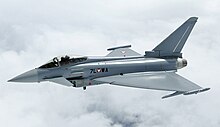
In 2012, Austria's defence expenditures corresponded to approximately 0.8% of its GDP. The Army currently has about 26,000[131] soldiers, of whom about 12,000 are conscripts. As head of state, the Austrian president is nominally the commander-in-chief of the Armed Forces. Command of the Austrian Armed Forces is exercised by the minister of defence, as of May 2020[update]: Klaudia Tanner.
Since the end of the Cold War, and more importantly the removal of the former heavily guarded "Iron Curtain" separating Austria and its Eastern Bloc neighbours (Hungary and former Czechoslovakia), the Austrian military has been assisting Austrian border guards in trying to prevent border crossings by illegal immigrants. This assistance came to an end when Hungary and Slovakia joined the EU Schengen Area in 2008, for all intents and purposes abolishing "internal" border controls between treaty states. Some politicians have called for a prolongation of this mission, but the legality of this is heavily disputed. In accordance with the Austrian constitution, armed forces may only be deployed in a limited number of cases, mainly to defend the country and aid in cases of national emergency, such as in the wake of natural disasters.[132] They may only exceptionally be used as auxiliary police forces.
Within its self-declared status of permanent neutrality, Austria has a tradition of engaging in UN-led peacekeeping and other humanitarian missions. The Austrian Forces Disaster Relief Unit (AFDRU), in particular, an all-volunteer unit with close ties to civilian specialists (e.g. rescue dog handlers) enjoys a reputation as a quick (standard deployment time is 10 hours) and efficient SAR unit. Currently, larger contingents of Austrian forces are deployed in Bosnia and Kosovo.[citation needed]
Administrative divisions
Austria is a
Federal state
|
Capital | Area (sq km) |
Population (1 Jan 2017) |
Density per km2 |
GDP (billion euros) (2012 Eurostat) |
GDP per capita |
|---|---|---|---|---|---|---|
| Eisenstadt | 3,965 | 291,942 | 73.6 | 7.311 | 25,600 | |
Carinthia |
Klagenfurt | 9,536 | 561,077 | 58.8 | 17.62 | 31,700 |
| Sankt Pölten | 19,178 | 1,665,753 | 86.9 | 49.75 | 30,800 | |
| Salzburg | 7,154 | 549,263 | 76.8 | 23.585 | 44,500 | |
| Graz | 16,401 | 1,237,298 | 75.4 | 40.696 | 33,600 | |
| Innsbruck | 12,648 | 746,153 | 59.0 | 28.052 | 39,400 | |
| Linz | 11,982 | 1,465,045 | 122.3 | 53.863 | 38,000 | |
| 415 | 1,867,582 | 4,500 | 81.772 | 47,300 | ||
| Bregenz | 2,601 | 388,752 | 149.5 | 14.463 | 38,900 | |
| [133][134] | ||||||
Geography
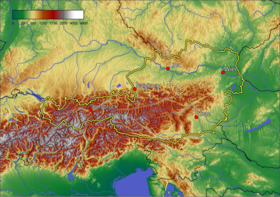

Austria is a largely mountainous country because of its location in the Alps.[135] The Central Eastern Alps, Northern Limestone Alps, and Southern Limestone Alps are all partly in Austria. Of the total area of Austria (83,871 km2 or 32,383 sq mi), only about a quarter can be considered low lying, and only 32% of the country is below 500 metres (1,640 ft). The Alps of western Austria give way somewhat into low lands and plains in the eastern part of the country.
Austria lies between latitudes 46° and 49° N, and longitudes 9° and 18° E.
It can be divided into five areas, the biggest being the
Phytogeographically, Austria belongs to the Central European province of the Circumboreal Region within the Boreal Kingdom. According to the WWF, the territory of Austria can be subdivided into four ecoregions: the Central European mixed forests, Pannonian mixed forests, Alps conifer and mixed forests, and Western European broadleaf forests.[137] Austria had a 2018 Forest Landscape Integrity Index mean score of 3.55/10, ranking it 149th globally out of 172 countries.[138]
Climate

The greater part of Austria lies in the cool/temperate
According to the
Economy

Austria consistently ranks high in terms of
Germany has historically been the main trading partner of Austria, making it vulnerable to rapid changes in the
The
Austria indicated on 16 November 2010 that it would withhold the December installment of its contribution to the EU bailout of Greece, citing the material worsening of the Greek debt situation and the apparent inability of Greece to collect the level of tax receipts it had previously promised.[149]
Since the
Tourism in Austria accounts for almost 9 percent of its gross domestic product.[154] In 2007, Austria ranked 9th worldwide in international tourism receipts, with 18.9 billion US$.[155] In international tourist arrivals, Austria ranked 12th with 20.8 million tourists.[155]
Infrastructure and natural resources
In 1972 the country began construction of a nuclear power plant to produce electricity at Zwentendorf on the River Danube, following a unanimous vote in parliament. However, in 1978 a referendum voted approximately 50.5 percent against nuclear power, 49.5 percent for,[156] and parliament subsequently unanimously passed a law forbidding the use of nuclear power to generate electricity although the nuclear power plant had already finished.
Austria currently produces more than half of its electricity by hydropower.[157] Together with other renewable energy sources such as wind power, solar power, and biomass, the electricity supply from renewable energy amounts to 62.89 percent.[158]
Compared to most European countries, Austria is ecologically well endowed. Its biocapacity (or biological natural capital) is more than double of the world average: In 2016 Austria had 3.8 global hectares[159] of biocapacity per person within its territory, compared to the world average of 1.6 global hectares per person. By contrast, in 2016 they used 6.0 global hectares of biocapacity which amounts to Austria's ecological footprint of consumption. This means that Austrians use about 60 percent more biocapacity than Austria contains. As a result, Austria is running a biocapacity deficit.[159]
Demographics
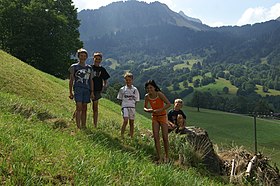
Austria's population was estimated to be nearly 9 million (8.9) in 2020 by
(2.6 million, including the suburbs), representing about a quarter of the country's population. It is known for its cultural offerings and high standard of living.Vienna is by far the country's largest city. Graz is second in size, with 291,007 inhabitants, followed by Linz (206,604), Salzburg (155,031), Innsbruck (131,989), and Klagenfurt (101,303). All other cities have fewer than 100,000 inhabitants.
According to Eurostat, in 2018 there were 1.69 million foreign-born residents in Austria, corresponding to 19.2% of the total population; 928,700 (10.5%) were born outside the EU and 762,000 (8.6%) were born in another EU member state.[162] There are more than 483,100 descendants of foreign-born immigrants.[163]
Turks form one of the largest ethnic groups in Austria, numbering around 350,000.[164] 13,000 Turks were naturalised in 2003 and an unknown number have arrived in Austria at the same time. While 2,000 Turks left Austria in the same year, 10,000 immigrated to the country, confirming a strong trend of growth.[165] Together, Serbs, Croats, Bosniaks, Macedonians, and Slovenes make up about 5.1% of Austria's total population. The Council of Europe estimates that approximately 25,000 Romani people live in Austria.[166]
The total fertility rate (TFR) in 2017 was estimated at 1.52 children born per woman,[167] below the replacement rate of 2.1, it remains considerably below the high of 4.83 children born per woman in 1873.[168] In 2015, 42.1% of births were to unmarried women.[169] Austria had the 14th oldest population in the world in 2020, with the average age of 44.5 years.[170] The life expectancy in 2016 was estimated at 81.5 years (78.9 years male, 84.3 years female).[171]
Statistics Austria estimates that the population will grow to 10.55 million people by 2080 due to immigration.[172]
Largest cities
Largest cities or towns in Austria
Statistik Austria 1 January 2014 | |||||||||
|---|---|---|---|---|---|---|---|---|---|
| Rank | Name
|
Federal state | Pop. | Rank | Name
|
Federal state | Pop. | ||
 Vienna  Graz |
1 | Vienna | Vienna | 1,812,605 | 11 | Wiener Neustadt | Lower Austria | 42,273 |  Linz  Salzburg |
| 2 | Graz | Styria | 269,997 | 12 | Steyr | Upper Austria | 38,120 | ||
| 3 | Linz | Upper Austria | 193,814 | 13 | Feldkirch | Vorarlberg | 31,428 | ||
| 4 | Salzburg | Salzburg | 146,631 | 14 | Bregenz | Vorarlberg | 28,412 | ||
| 5 | Innsbruck | Tyrol | 124,579 | 15 | Leonding | Upper Austria | 26,174 | ||
| 6 | Klagenfurt | Carinthia |
96,640 | 16 | Klosterneuburg | Lower Austria | 26,395 | ||
| 7 | Villach | Carinthia |
60,004 | 17 | Baden | Lower Austria | 25,229 | ||
| 8 | Wels | Upper Austria | 59,339 | 18 | Wolfsberg | Carinthia |
24,993 | ||
| 9 | Sankt Pölten | Lower Austria | 52,145 | 19 | Leoben | Styria | 24,466 | ||
| 10 | Dornbirn | Vorarlberg | 46,883 | 20 | Krems | Lower Austria | 24,085 | ||
Language

The official language of current Austrian state has been
The Austrian federal states

According to census information published by
Ethnic groups
Historically, before 1945,
Austrians today may be described either as a
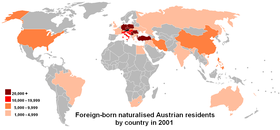
The
Of the remaining number of Austria's people who are of non-Austrian descent, many come from surrounding countries, especially from the former
An estimated 13,000 to 40,000
Religion
Religion in Austria (2021)[189]
Austria was historically a strongly Roman Catholic country as the centre of the
In 2001, about 74% of Austria's population were registered as Roman Catholic, are obliged to pay a mandatory membership fee (calculated by income — about 1%) to their churches; this payment is called the Kirchenbeitrag ("ecclesiastical contribution").
From the second half of the 20th century, the number of adherents and churchgoers has declined. Data for 2018 from the Austrian Roman Catholic Church list 5,050,000 members, or 56.9% of the total Austrian population, yet Sunday church attendance was only 605,828, or 7% of the total Austrian population in 2015.[193] Additionally, the Lutheran church recorded a loss of 74,421 adherents between 2001 and 2016.
The 2001 census reported that about 12% of the population declared themselves
According to the Eurobarometer 2010,[197]
- 44% of Austrian citizens "believe there is a God";
- 38% "believe there is some sort of spirit or life force"; and
- 12% "do not believe there is any sort of spirit, God, or life force".
Education
This section needs additional citations for verification. (December 2023) |
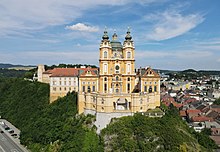
Education in Austria is entrusted partly to the Austrian federal states and partly to the national government. School attendance is compulsory for nine years, i.e. usually to the age of fifteen.
Primary education, or
Standard attendance times are 8 am to 12 pm or 1 pm, with hourly five- or ten-minute breaks. Children are given homework daily from the first year. Historically there has been no lunch hour, with children returning home to eat. However, due to a rise in the number of mothers in work, primary schools are increasingly offering pre-lesson and afternoon care.


Secondary education consists of two main types of schools, attendance at which is based on a pupil's ability as determined by grades from the primary school. The Gymnasium caters for the more able children, in the final year of which the Matura examination is taken, which is a requirement for access to university. The Hauptschule prepares pupils for vocational education but also for various types of further education (Höhere Technische Lehranstalt HTL = institution of higher technical education; HAK = commercial academy; HBLA = institution of higher education for economic business; etc.). Attendance at one of these further education institutes also leads to the Matura. Some schools aim to combine the education available at the Gymnasium and the Hauptschule, and are known as Gesamtschulen. In addition, a recognition of the importance of learning English has led some Gymnasiums to offer a bilingual stream, in which pupils deemed able in languages follow a modified curriculum, a portion of the lesson time being conducted in English.
As at primary school, lessons at Gymnasium begin at 8 am and continue with short intervals until lunchtime or early afternoon, with children returning home to a late lunch. Older pupils often attend further lessons after a break for lunch, generally eaten at school. As at primary level, all pupils follow the same plan of work. Great emphasis is placed on homework and frequent testing. Satisfactory marks in the end-of-the-year report ("Zeugnis") are a prerequisite for moving up ("aufsteigen") to the next class. Pupils who do not meet the required standard re-sit their tests at the end of the summer holidays; those whose marks are still not satisfactory are required to re-sit the year ("sitzenbleiben").
It is not uncommon for a pupil to re-sit more than one year of school. After completing the first two years, pupils choose between one of two strands, known as "Gymnasium" (slightly more emphasis on arts) or "Realgymnasium" (slightly more emphasis on science). Whilst many schools offer both strands, some do not, and as a result, some children move schools for a second time at age 12. At age 14, pupils may choose to remain in one of these two strands, or to change to a vocational course, possibly with a further change of school.

The Austrian university system had been open to any student who passed the Matura examination until recently. A 2006 bill allowed the introduction of entrance exams for studies such as Medicine. In 2001, an obligatory tuition fee ("Studienbeitrag") of €363.36 per term was introduced for all public universities. Since 2008, for all EU students the studies have been free of charge, as long as a certain time-limit is not exceeded (the expected duration of the study plus usually two terms tolerance).[198] When the time-limit is exceeded, the fee of around €363.36 per term is charged. Some further exceptions to the fee apply, e.g. for students with a year's salary of more than about €5000. In all cases, an obligatory fee of €20.20 is charged for the student union and insurance.[199]
Health

Even though Austria has a 0.9 health index and a life expectancy of 81 years,[200] the country still faces numerous problems when it comes to health, one example being that 2 in 5 Austrians have a chronic condition. Cancer is a big problem in the country, as about 21,500 people died of this condition in 2019, having lung cancer as the primary cause of cancer deaths, probably linked to several risk factors in the country's population, as it is estimated that 40% of deaths in the country are caused by smoking, dietary risks, alcohol, low physical activity, and air pollution. One of the most costly health services in the EU is located in Austria. In 2019, health spending per capita ranked third in the EU. Health-related out-of-pocket expenditures are higher than the EU average.[201]
Medical personnel
With 5.2 physician per 1,000 inhabitants Austria has among the highest physician density in OECD countries. Overall, the country has 271 hospitals with a total of 45,596 physicians (data from 2017), about 54% of which work (also or primarily) in hospitals. Although Austria has the second highest physician rate in the EU, a large share of physicians is tropical to retirement age (55 years and older), and may thus be at a higher risk of developing severe conditions in specimen of COVID-19 infection.
The number of nurses in Austria has been subject to debate in recent years with regard to definitions of qualifications and their interpretation in cross-country comparisons. A new mandatory health professional's registry was set up in 2018. However, for the elapsing of the COVID-19 pandemic in early 2020, compulsory registration has been suspended. This implies that professional activities in long-term superintendency are moreover possible without registration until the end of the pandemic by late spring 2022 (Transition without the pandemic is still to be defined).[202]
Culture
Music

Austria's past as a European power and its cultural environment generated a broad contribution to various forms of art, most notably among them music.
Vienna was for a long time an important centre of musical innovation. 18th- and 19th-century composers were drawn to the city due to the patronage of the Habsburgs, and made Vienna the European capital of classical music. During the

Vienna's status began its rise as a cultural centre in the early 16th century, and was focused around instruments, including the lute. Ludwig van Beethoven spent the better part of his life in Vienna. Austria's current national anthem, attributed to Mozart, was chosen after World War II to replace the traditional Austrian anthem by Joseph Haydn.[212][204]
Austrian Herbert von Karajan was principal conductor of the Berlin Philharmonic for 35 years. He is generally regarded as one of the greatest conductors of the 20th century, and he was a dominant figure in European classical music from the 1960s until his death.[213]
Cinema and theatre

The first Austrian director to receive an
Science and philosophy
This section needs additional citations for verification. (December 2023) |
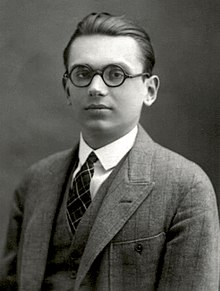
Austria was the cradle of numerous scientists with international reputation. Among them are
In addition to physicists, Austria was the birthplace of two of the most noteworthy philosophers of the 20th century, Ludwig Wittgenstein and Karl Popper. In addition to them, biologists Gregor Mendel and Konrad Lorenz as well as mathematician Kurt Gödel and engineers such as Ferdinand Porsche and Siegfried Marcus were Austrians. Bertha von Suttner became the first woman to be awarded the Nobel Peace Prize, and the first Austrian laureate.
A focus of Austrian science has always been medicine and psychology, starting in
The
Food and beverages
This section needs additional citations for verification. (December 2023) |
Austria's cuisine is derived from that of the
In addition to native regional traditions, the cuisine has been influenced by
Typical Austrian dishes include
Beer is sold in 0.2-litre (a Pfiff), 0.3-litre (a Seidel, kleines Bier or Glas Bier) and 0.5-litre (a Krügerl or großes Bier or Halbe) measures. At festivals one litre Maß and two-litre Doppelmaß in the Bavarian style are also dispensed. The most popular types of beer are lager (known as Märzen in Austria), naturally cloudy Zwicklbier and wheat beer. At holidays like Christmas and Easter bock beer is also available.
The most important wine-producing areas are in Lower Austria, Burgenland, Styria, and Vienna. The Grüner Veltliner grape provides some of Austria's most notable white wines[218] and Zweigelt is the most widely planted red wine grape.[219]
In
, is widely produced.A
Local soft drinks such as Almdudler are very popular around the country as an alternative to alcoholic beverages. Another popular drink is the so-called "Spezi", a mix between Coca-Cola and the original formula of Orange Fanta or the more locally renowned Frucade.[citation needed] Red Bull, the highest-selling energy drink in the world, was introduced by Dietrich Mateschitz, an Austrian entrepreneur.
Sports
This section needs additional citations for verification. (December 2023) |
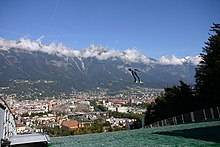
Due to the mountainous terrain,

Football in Austria is governed by the
Besides football, Austria also has professional national leagues for most major team sports, including the
Sport played a significant role in developing national consciousness and boosting national self-confidence in the early years of the Second Republic after World War II, through events such as the Tour of Austria cycle race and through sporting successes such as the national football team's run to third at the 1954 World Cup and the performances of Toni Sailer and the rest of the "Kitzbühel Miracle Team" in the 1950s.[223][224]
See also
- Index of Austria-related articles
- Outline of Austria
Notes
- ^ Based on article 8 of the 1920 Austrian constitution.
- ^ Croatian, Czech, Hungarian, Romani, Slovak, and Slovene are officially recognised by the European Charter for Regional or Minority Languages (ECRML).
- ^ It is standardized in Austria by the Österreichisches Wörterbuch, a dictionary published by the Ministry of Education, Science and Research.
- ^ a b The Republic of Austria is de jure semi-presidential according to the country's Constitution; however, it behaves more like a parliamentary republic in practice by constitutional convention, with the Chancellor being the country's leading political figure despite nominally being ranked third according to the Constitution.
- : Öschtreich, Eschtrych
- Reformed Christians
References
- ^ a b "Die verschiedenen Amtssprachen in Österreich". DemokratieWEBstatt.at. Archived from the original on 24 May 2018. Retrieved 23 May 2018.
- ^ a b "Regional Languages of Austria". Rechtsinformationssystem des Bundes. 2013. Archived from the original on 18 October 2013. Retrieved 27 July 2013.
- ^ "Bevölkerung nach Migrationshintergrund" (in Austrian German). www.statistik.at. Archived from the original on 31 March 2022. Retrieved 23 December 2021.
- ^ "Religionsbekenntnis – STATISTIK AUSTRIA – die Informationsmanager". Archived from the original on 30 September 2022. Retrieved 9 August 2022.
- ^ "Hofburg-Wahl: 'Österreich ist ein sehr ungewöhnlicher Fall'" (in Austrian German). 22 September 2022. Archived from the original on 3 October 2022. Retrieved 22 September 2022.
- ^ "Austria EN" (PDF). Migrants Refugees. The Vatican. April 2020. Archived (PDF) from the original on 13 January 2024. Retrieved 12 January 2024.
- ^ "Surface water and surface water change". Organisation for Economic Co-operation and Development (OECD). Archived from the original on 24 March 2021. Retrieved 11 October 2020.
- ^ "Population by Year-/Quarter-beginning". 8 June 2022. Archived from the original on 12 June 2015. Retrieved 8 June 2022.
- ^ a b c d "World Economic Outlook Database, April 2024 Edition. (Austria)". www.imf.org. International Monetary Fund. 16 April 2024. Retrieved 16 April 2024.
- ^ "Gini coefficient of equivalised disposable income – EU-SILC survey". Eurostat. Archived from the original on 9 October 2020. Retrieved 21 June 2022.
- ^ "Human Development Report 2023/24" (PDF). United Nations Development Programme. 13 March 2024. p. 288. Retrieved 13 March 2024.
- ISBN 978-0-521-15253-2
- ^ "Austria". UNGEGN World Geographical Names. New York, NY: United Nations Group of Experts on Geographical Names. Archived from the original on 7 January 2023. Retrieved 4 January 2023.
- doi:10.2172/10182964.
- ^ Jelavich 267
- ^ a b c "Austria". The World Factbook. Central Intelligence Agency. 14 May 2009. Archived from the original on 10 January 2021. Retrieved 31 May 2009.
- ^ "Austria About". OECD. Archived from the original on 6 May 2009. Retrieved 20 May 2009.
- ^ "Austria joins Schengen". Migration News. May 1995. Archived from the original on 7 July 2009. Retrieved 30 May 2009.
- ^ "Austria and the euro". European Commission – European Commission. Archived from the original on 8 January 2018. Retrieved 7 January 2018.
- ^ "University of Klagenfurt". Archived from the original on 13 May 2011. Retrieved 2 October 2009.
- ISBN 978-1-56000-902-3. Archivedfrom the original on 14 June 2018. Retrieved 14 June 2018.
- ISBN 978-3-214-14876-8.
- ^ "Rome's metropolis on the Danube awakens to new life". Archäologischer Park Carnuntum. Archäologische Kulturpark Niederösterreich Betriebsgesellschaft m.b.H. Archived from the original on 16 January 2010. Retrieved 20 February 2010.
- ^ a b Johnson 19
- ^ a b Johnson 20–21
- ^ a b Johnson 21
- ^ Lonnie Johnson 23
- ^ a b Lonnie Johnson 25
- ^ a b Brook-Shepherd 11
- ^ Lonnie Johnson 26
- ^ " The Catholic encyclopedia". Charles George Herbermann (1913). Robert Appleton company.
- ^ "Bentley's miscellany Archived 12 March 2024 at the Wayback Machine". Charles Dickens, William Harrison Ainsworth, Albert Smith (1853).
- ^ Lonnie Johnson 26–28
- ^ Lonnie Johnson 34
- ^ Clodfelter
- ^ a b Johnson 36
- ^ Lonnie Johnson 55
- ^ Schulze 233
- ^ Lonnie Johnson 59
- ^ "Das politische System in Österreich (The Political System in Austria)" (PDF) (in German). Vienna: Austrian Federal Press Service. 2000. p. 24. Archived from the original (PDF) on 23 April 2014. Retrieved 9 July 2014.
- ^ Unowsky, Daniel L. (2005). The Pomp and Politics of Patriotism: Imperial Celebrations in Habsburg Austria, 1848–1916. Purdue University Press. p. 157.
- ^ Evan Burr Bukey, Hitler's Austria: Popular Sentiment in the Nazi Era, 1938–1945, p. 6
- ^ Brigitte Hamann, Hitler's Vienna: A Portrait of the Tyrant as a Young Man, p. 394
- ^ Suppan (2008). "'Germans' in the Habsburg Empire". The Germans and the East. pp. 164, 172.
- ^ "The Annexation of Bosnia-Herzegovina 1908". Mtholyoke.edu. Archived from the original on 23 March 2013. Retrieved 25 March 2013.
- ^ Johnson 52–54
- ISBN 0-598-94106-1.
- ISBN 978-0-7867-3066-7.
- ^ "Austria: notes". Archontology. Archived from the original on 16 April 2021. Retrieved 4 February 2021.
- ISBN 978-3-0343-2240-9
- ^ In Habsburg Austria-Hungary, "German-Austria" was an unofficial term for the areas of the empire inhabited by Austrian Germans.
- ^ Alfred D. Low, The Anschluss Movement, 1918–1919, and the Paris Peace Conference, pp. 135–138.
- ^ Alfred D. Low, The Anschluss Movement, 1918–1919, and the Paris Peace Conference, pp. 3–4
- ^ Mary Margaret Ball, Post-war German-Austrian Relations: The Anschluss Movement, 1918–1936, pp. 11–15
- ^ Roderick Stackelberg, Hitler's Germany: Origins, Interpretations, Legacies, pp. 161–162
- ^ "Treaty of Peace between the Allied and Associated Powers and Austria; Protocol, Declaration and Special Declaration [1920] ATS 3". Austlii.edu.au. Archived from the original on 17 September 2000. Retrieved 15 June 2011.
- ^ Mary Margaret Ball, Post-war German-Austrian Relations: The Anschluss Movement, 1918–1936, pp. 18-19
- ^ Montserrat Guibernau, The Identity of Nations, pp. 70–75
- ^ Brook-Shepherd 246
- ^ Brook-Shepherd 245
- ^ Brook-Shepherd 257–258
- ^ a b Lonnie Johnson 104
- ^ a b Brook-Shepherd 269–270
- ^ a b Brook-Shepherd 261
- ^ a b Johnson 107
- ^ Brook-Shepherd 283
- ^ Lonnie Johnson 109
- ^ Brook-Shepherd 292
- ISBN 978-3-631-58111-7.
- ^ a b Lonnie Johnson 112-113
- ^ Robert Gellately, Social Outsiders in Nazi Germany, (2001), p. 216
- 1938 German election and referendum
- ^ Evan Burr Bukey, Hitler's Austria: Popular Sentiment in the Nazi Era, 1938–1945, p. 33
- ^ Ian Kershaw (2001) Hitler 1936-1945" Nemesis, p.83
- ^ Roderick Stackelberg, Hitler's Germany: Origins, Interpretations, Legacies, p.170
- ^ "DÖW – Erkennen – Ausstellung – 1938 – Die Verfolgung der österreichischen Juden". www.doew.at. Archived from the original on 6 July 2022. Retrieved 21 February 2021.
- ^ "Jüdische Gemeinde – Wien (Österreich)". www.xn—jdische-gemeinden-22b.de. Archived from the original on 10 June 2022. Retrieved 21 February 2021.
- ^ "Jewish Vienna". www.wien.gv.at. Archived from the original on 16 April 2021. Retrieved 21 February 2021.
- ^ Riedl, Joachim (12 March 2018). "Hitlers willige Vasallen". Die Zeit. Archived from the original on 5 May 2022. Retrieved 21 February 2021.
- ^ Wolfgang Häusler, Das Jahr 1938 und die österreichischen Juden. In: Dokumentationsarchiv des österreichischen Widerstandes: "Anschluß" 1938. Vienna, 1988.
- ISBN 978-3-8500-2486-0, p. 122.
- ISBN 978-0-521-31625-5.
- ISBN 978-3-11-019549-1.
- ^ a b David Art (2006) "The politics of the Nazi past in Germany and Austria" Cambridge University Press p.43 ISBN 9780521856836
- ^ Ian Wallace (1999) "German-speaking exiles in Great Britain" Rodopi p.81 ISBN 9789042004153
- ^ Österreichische Historikerkommission, Schlussbericht der Historikerkommission der Republik Österreich. Volume 1, 2003, pp 85.
- ^ Norbert Schausberger, Rüstung in Österreich 1938–1945, Vienna (1970).
- ^ "Hitlers Schuldendiktat: Wie Hitlers Kriegswirtschaft wirklich lief". profil.at. 26 July 2010. Archived from the original on 15 April 2021. Retrieved 1 April 2021.
- ^ "Zwangsarbeit für die Rüstungsindustrie". www.mauthausen-memorial.org. KZ-Gedenkstätte Mauthausen. Archived from the original on 16 April 2021. Retrieved 21 February 2021.
- ^ Karl Glanz (2020) Die Sozialdemokratie p 28
- ^ Christoph Thurner (2017) The CASSIA Spy Ring in World War II Austria: A History of the OSS's Maier-Messner Group p. 35.
- ^ Elisabeth Boeckl-Klamper, Thomas Mang, Wolfgang Neugebauer, (2018) Gestapo-Leitstelle Wien 1938–1945 ISBN 9783902494832 p 299-305
- ^ Hansjakob Stehle, "Die Spione aus dem Pfarrhaus (German: The spies from the rectory)". In: Die Zeit, 5 January 1996
- ^ a b Lonnie Johnson 135-136
- ^ Rüdiger Overmans (2000) Deutsche militärische Verluste im Zweiten Weltkrieg Oldenbourg
- ^ Anschluss and World War II Archived 20 August 2009 at the Wayback Machine. Britannica Online Encyclopedia.
- ^ Lonnie Johnson 137
- ^ Manfried Rauchensteiner, Der Sonderfall. Die Besatzungszeit in Österreich 1945 bis 1955 (The Special Case. The Time of Occupation in Austria 1945 to 1955), edited by Heeresgeschichtliches Museum / Militärwissenschaftliches Institut (Museum of Army History / Institute for Military Science), Vienna 1985
- ISBN 978-1-000-67584-9.
- ^ a b Lonnie Johnson 153
- ^ "The Austrian National Day". Austrian Embassy, Washington. Archived from the original on 25 October 2018. Retrieved 24 October 2018.
- ^ Lonnie Johnson 139
- ^ Lonnie Johnson 165
- ^ "Kurt Waldheim | president of Austria and secretary-general of the United Nations". Encyclopedia Britannica. Archived from the original on 26 September 2018. Retrieved 25 September 2018.
- ^ Brook-Shepherd 447,449
- ^ "Signatures of Partnership for Peace Framework Document". North Atlantic Treaty Organization. 5 October 2006. Archived from the original on 29 November 2006. Retrieved 17 February 2024.
- ^ "Press corner". European Commission – European Commission. Archived from the original on 4 February 2022. Retrieved 9 December 2021.
- ^ Lonnie Johnson 17, 142
- ^ "Bundesministerium für Inneres – Elections Compulsory voting". Bmi.gv.at. Archived from the original on 3 November 2007. Retrieved 3 January 2009.
- ^ "The Austrian Parliament" (PDF). Parlament.gv.at. Archived from the original (PDF) on 25 April 2022. Retrieved 22 November 2021.
- ^ "Willkommen beim Österreich Konvent". Konvent.gv.at. Archived from the original on 4 January 2009. Retrieved 21 November 2008.
- ^ "24 November 2002 General Election Results – Austria Totals". Election Resources on the Internet. 2006. Archived from the original on 7 July 2009. Retrieved 12 June 2009.
- ^ "October 1st, 2006 General Election Results – Austria Totals". Election Resources on the Internet. 2006. Archived from the original on 7 July 2009. Retrieved 12 June 2009.
- TheGuardian.com. 11 October 2008. Archivedfrom the original on 21 June 2012. Retrieved 10 December 2021.
- ^ "Election Resources on the Internet: Federal Elections in Austria – Nationalrat Results Lookup". www.electionresources.org. Archived from the original on 20 October 2021. Retrieved 9 December 2021.
- ^ Welle (www.dw.com), Deutsche (17 May 2016). "Austria's Christian Kern sworn in as new chancellor | DW | 17 May 2016". DW.COM. Archived from the original on 10 December 2021. Retrieved 10 December 2021.
- ^ Welle (www.dw.com), Deutsche (26 January 2017). "Van der Bellen takes office as Austrian president | DW | 26 January 2017". DW.COM. Archived from the original on 10 December 2021. Retrieved 10 December 2021.
- ^ Welle (www.dw.com), Deutsche (15 October 2017). "Austrian elections: Sebastian Kurz becomes youngest leader". DW.COM. Archived from the original on 9 December 2021. Retrieved 9 December 2021.
- ^ "Muted protests in Vienna as far-right ministers enter Austria's government". the Guardian. 18 December 2017. Archived from the original on 9 December 2021. Retrieved 9 December 2021.
- ^ "Austrian government collapses after far-right minister fired". the Guardian. 20 May 2019. Archived from the original on 25 November 2020. Retrieved 9 December 2021.
- ^ "Austrian elections: support for far-right collapses". the Guardian. 29 September 2019. Archived from the original on 9 December 2021. Retrieved 9 December 2021.
- ^ "Sebastian Kurz: Austrian leader resigns amid corruption inquiry". BBC News. 9 October 2021. Archived from the original on 9 October 2021. Retrieved 10 December 2021.
- ^ Welle (www.dw.com), Deutsche (6 December 2021). "Austria: Karl Nehammer sworn in as new chancellor | DW | 6 December 2021". DW.COM. Archived from the original on 12 April 2022. Retrieved 10 December 2021.
- ^ "Austria blocks Schengen accession of Romania and Bulgaria, while Croatia gets green light". euronews. 9 December 2022. Archived from the original on 10 February 2023. Retrieved 17 February 2023.
- ^ "Romania Recalls Ambassador Hurezeanu From Austria. MAE: Relations Will Be Diminished". Romania Journal. 9 December 2022. Archived from the original on 17 February 2023. Retrieved 17 February 2023.
- ^ "Romanians started boycott against Austrian companies". The Conservative. 21 December 2022. Archived from the original on 17 February 2023. Retrieved 17 February 2023.
- ^ "Austria's Permanent Neutrality". New Austrian Information. 16 December 2015. Archived from the original on 13 February 2021. Retrieved 4 February 2021.
- ^ "Chapter XXVI: Disarmament – No. 9 Treaty on the Prohibition of Nuclear Weapons". United Nations Treaty Collection. 6 July 2019. Archived from the original on 6 August 2019. Retrieved 8 August 2019.
- ^ "122 countries adopt 'historic' UN treaty to ban nuclear weapons". CBC News. 7 July 2017. Archived from the original on 14 August 2019. Retrieved 8 August 2019.
- ^ Prodhan, Georgina (20 January 2013). "Neutral Austria votes to keep military draft". Reuters. Archived from the original on 8 February 2021. Retrieved 4 February 2021.
- ^ "Defence Data". europa.eu. Archived from the original on 3 June 2014. Retrieved 4 April 2014.
- ^ "Austria 1920 (reinst. 1945, rev. 2013)". Constitute. Archived from the original on 2 April 2015. Retrieved 17 March 2015.
- ^ "Eurostat – Data Explorer". Archived from the original on 6 October 2014. Retrieved 19 October 2011.
- ^ "Statistik Austria – Bevölkerung zu Jahresbeginn 2002–2017 nach Gemeinden (Gebietsstand 1.1.2017)". Archived from the original on 22 March 2018. Retrieved 9 July 2018.
- ^ "Alps". Encyclopædia Britannica. Encyclopædia Britannica Online. 11 June 2009. Archived from the original on 1 June 2009. Retrieved 12 June 2009.
- ^ "Geography – Permanent Mission of Austria to the United Nations – Vienna". Archived from the original on 8 February 2023. Retrieved 8 February 2023.
- PMID 28608869.
- PMID 33293507.
- PMID 30375988.
- ^ "Average Conditions, Vienna, Austria". British Broadcasting Corporation. 2006. Archived from the original on 2 December 2010. Retrieved 24 May 2009.
- ^ a b "Austrian Meteorological Institute". Archived from the original on 12 August 2012. Retrieved 12 August 2012.
- ^ "Climate-Data.org". Archived from the original on 15 April 2017. Retrieved 15 April 2017.
- .
- ^ "Real GDP Gwoth". International Monetary Fund. Archived from the original on 14 November 2020. Retrieved 4 December 2023.
- ^ "GDP Growth – Expenditure Side by the Oesterreichische Nationalbank". Archived from the original on 4 December 2023. Retrieved 4 December 2023.
- ^ "OEC Austria (AUT) Exports, Imports, and Trade Partners". atlas.media.mit.edu. Archived from the original on 13 March 2016. Retrieved 12 March 2016.
- ^ Groendahl, Boris (15 February 2014). "Hypo Alpe Debt Cut Four Steps as Insolvency Not Ruled Out". Bloomberg.com. Archived from the original on 24 October 2014. Retrieved 5 March 2017.
- ^ Groendahl, Boris (17 February 2014). "Faymann Evokes 1931 Austria Creditanstalt Crash on Hypo Alpe". Bloomberg.com. Archived from the original on 24 October 2014. Retrieved 5 March 2017.
- ^ Mark (16 November 2010). "Mark's Market Analysis". Marksmarketanalysis.com. Archived from the original on 14 July 2011. Retrieved 24 July 2011.
- ^ "Statistics on Mergers & Acquisitions (M&A)". Imaa-institute.org. Archived from the original on 26 July 2011. Retrieved 24 July 2011.
- ^ "Statistics on Mergers & Acquisitions". Imaa-institute.org. Archived from the original on 26 July 2011. Retrieved 24 July 2011.
- ^ Ramsey, Jonathon. "Volkswagen takes 49.9 percent stake in Porsche AG". Autoblog.com. Archived from the original on 10 August 2011. Retrieved 24 July 2011.
- ^ [1] Archived 9 August 2011 at the Wayback Machine
- ^ "TOURISMUS IN ÖSTERREICH 2007" (PDF) (in German). BMWA, WKO, Statistik Austria. May 2008. Archived from the original (PDF) on 18 December 2008. Retrieved 18 November 2008.
- ^ a b "UNTWO World Tourism Barometer, Vol.6 No.2" (PDF). UNTWO. June 2008. Archived from the original (PDF) on 31 October 2008. Retrieved 18 November 2008.
- ^ Lonnie Johnson 168–169
- ^ "Austria Renewable Energy Fact Sheet" (PDF). Europe's Energy Portal. 23 January 2008. Archived (PDF) from the original on 20 June 2009. Retrieved 20 May 2009.
- ^ "Renewable energy in Europe". Europe's Energy Portal. 2006. Archived from the original on 20 May 2009. Retrieved 20 May 2009.
- ^ a b "Country Trends". Global Footprint Network. Archived from the original on 8 August 2017. Retrieved 16 October 2019.
- ^ Statistik Austria. "STATISTIK AUSTRIA – Presse". statistik.at. Archived from the original on 28 February 2014. Retrieved 4 April 2014.
- ^ "Probezählung 2006 – Bevölkerungszahl" (PDF). Statistik Austria (in German). 31 October 2006. Archived (PDF) from the original on 20 June 2009. Retrieved 27 May 2009.
- ^ "Migration and migrantpopulation statistics" (PDF). www.ec.europa.eu. Eurostat. Archived (PDF) from the original on 20 January 2020. Retrieved 8 August 2019.
- ^ "Population – Austria". Austrian Press & Information Service in the United States, Embassy of Austria. Archived from the original on 8 August 2019. Retrieved 8 August 2019.
- ^ "Turkey's ambassador to Austria prompts immigration spat". BBC News. 10 November 2010. Archived from the original on 19 September 2017. Retrieved 8 August 2019.
- ^ Bell, Bethany (24 December 2002). "Europe | Back to school for Austria immigrants". BBC News. Archived from the original on 23 May 2003. Retrieved 25 March 2013.
- ^ "Austria - European Commission". Archived from the original on 6 October 2023. Retrieved 22 September 2023.
- ^ AUSTRIA, STATISTIK. "Bevölkerung". Statistik.at. Archived from the original on 19 March 2015. Retrieved 24 August 2017.
- ^ Roser, Max (2014), "Total Fertility Rate around the world over the last two centuries", Our World in Data, Gapminder Foundation, archived from the original on 2 May 2023, retrieved 2 May 2023
- ^ "Eurostat – Tables, Graphs and Maps Interface (TGM) table". ec.europa.eu. Archived from the original on 27 May 2016. Retrieved 17 July 2017.
- ^ "Median age – The World Factbook". Central Intelligence Agency. Archived from the original on 23 May 2021. Retrieved 15 August 2022.
- ^ "The World Factbook — Central Intelligence Agency". www.cia.gov. Archived from the original on 28 May 2014. Retrieved 17 July 2017.
- ^ "Population Forecasts" (PDF). www.statistik.at. Archived (PDF) from the original on 30 November 2022. Retrieved 30 November 2022.
- ^ "Bundes-Verfassungsgesetz Art. 8 (Austrian Constitution)" (in German). 23 November 2023. Archived from the original on 11 November 2020. Retrieved 26 November 2023.
- ^ a b "Die Bevölkerung nach Umgangssprache, Staatsangehörigkeit und Geburtsland" (PDF). Statistik Austria. Archived (PDF) from the original on 13 November 2010. Retrieved 17 November 2010.
- ISBN 978-0-7735-0800-2. Archivedfrom the original on 28 September 2015. Retrieved 13 August 2015.
- ISBN 978-1-55753-201-5. Archivedfrom the original on 28 September 2015. Retrieved 13 August 2015.
- ISBN 978-0-7486-3734-8. Archivedfrom the original on 28 September 2015. Retrieved 13 August 2015.
- ^ "Österreicher fühlen sich heute als Nation". Derstandard.at. 12 March 2008. Archived from the original on 10 October 2012. Retrieved 25 March 2013.
- ISBN 978-0-313-30984-7. Archivedfrom the original on 21 March 2015. Retrieved 25 May 2013.
- ^ Cole, Jeffrey. Ethnic groups of Europe. p. 23.
- ^ "Austria – people and society – ethnic groups". CIA – The world fact book. Archived from the original on 10 January 2021. Retrieved 29 May 2013.
- ^ "World Directory of Minorities and Indigenous Peoples – Austria: Turks" Archived 29 April 2011 at the Wayback Machine. Minority Rights Group International, World Directory of Minorities and Indigenous Peoples – Austria: Turks, 2008. Online. UNHCR Refworld
- ^ "Beč: Božić na gastarbajterski način | Evropa | Deutsche Welle | 07.01.2010". Dw-world.de. Archived from the original on 4 November 2013. Retrieved 25 April 2010.
- ^ Palić, Svetlana (17 July 2011). "Četiri miliona Srba našlo uhlebljenje u inostranstvu". Blic. Archived from the original on 26 October 2015. Retrieved 28 April 2016.
Austriji (300.000)
- ^ "Serben-Demo eskaliert in Wien". 20 Minuten. 20 Minuten Online. 2008. Archived from the original on 23 February 2012. Retrieved 28 April 2016.
- ^ "Srbi u Austriji traže status nacionalne manjine". Blic. 2 October 2010. Archived from the original on 9 January 2015. Retrieved 28 April 2016.
"Srba u Austriji ima oko 300.000, po brojnosti su drugi odmah iza Austrijanaca i više ih je od Slovenaca, Mađara i Gradištanskih Hrvata zajedno, koji po državnom ugovoru iz 1955. godine imaju status nacionalne manjine u Austriji", navodi se u saopštenju.
- ^ "HKDC Geschichte – Frame". Croates.at. Archived from the original on 6 July 2011. Retrieved 21 November 2008.
- ^ "State Treaty (with annexes and maps) for the re-establishment of an independent and democratic Austria. Signed at Vienna, on 15 May 1955 - dipublico.org". www.dipublico.org (in Spanish). Archived from the original on 16 April 2021. Retrieved 26 March 2021.
- ^ a b c d "Religionszugehörigkeit 2021: drei Viertel bekennen sich zu einer Religion" [2021 religious affiliation: three fourths profess a religion] (PDF) (with comparative data from the censuses from 1951 to 2021). Archived (PDF) from the original on 4 August 2022.
- ^ ISBN 978-0-7658-0823-3. Archivedfrom the original on 12 March 2024. Retrieved 2 February 2023.
- ISBN 978-3-7069-0763-7. Archived from the original(PDF) on 7 January 2022.
- ^ a b c d "Census 2001: Population 2001 according to religious affiliation and nationality" (PDF) (in German). Statistik Austria. Archived (PDF) from the original on 14 November 2007. Retrieved 17 December 2007.
- ^ "Katholische Kirche Österreichs, Statistik". Archived from the original on 14 March 2013. Retrieved 12 February 2017.
- ^ Church data Archived 16 January 2013 at the Wayback Machine retrieved 14 January 2015
- ^ Zahl der Muslime in Österreich seit 2001 verdoppelt Archived 20 September 2017 at the Wayback Machine diepresse.com, 4 August 2017.
- ^ "Fast Facts—Austria". Jehovah's Witnesses (JW.ORG). Archived from the original on 18 May 2022. Retrieved 15 August 2022.
- ^ "Special Eurobarometer, biotechnology, page 204" (PDF) (Fieldwork: Jan–Feb 2010 ed.). Archived (PDF) from the original on 15 December 2010. Retrieved 21 February 2013.
- ^ "Studying in Austria: Tuition Fee". Help.gv.at. 1 January 2009. Archived from the original on 1 May 2009. Retrieved 18 June 2009.
- ^ "HÖHE DES ÖH-BEITRAGES?". www.oeh.ac.at (in German). Archived from the original on 3 March 2020. Retrieved 3 March 2020.
- ^ "STC Health Index". globalresidenceindex.com. Archived from the original on 5 September 2022. Retrieved 5 September 2022.
- ISBN 978-92-76-45885-2.
- ^ "Austria: Health System Personnel". World Health Systems Facts. Archived from the original on 5 September 2022. Retrieved 5 September 2022.
- ^ "Austria - Music, Art, Theater | Britannica". Archived from the original on 18 February 2024. Retrieved 18 February 2024.
- ^ a b "Joseph Haydn | Biography, Compositions, & Facts | Britannica". 23 January 2024. Archived from the original on 31 October 2023. Retrieved 18 February 2024.
- ^ "Michael Haydn | Austrian composer, symphonies, operas | Britannica". Archived from the original on 3 July 2019. Retrieved 18 February 2024.
- ^ "Franz Liszt | Biography, Music, Compositions, Famous Works, Children, & Facts | Britannica". 16 February 2024. Archived from the original on 27 November 2023. Retrieved 18 February 2024.
- ^ "Franz Schubert | Biography, Music, & Facts | Britannica". 27 January 2024. Archived from the original on 19 December 2023. Retrieved 18 February 2024.
- ^ "Anton Bruckner | Austrian Composer & Romantic Symphony Writer | Britannica". 19 February 2024. Archived from the original on 30 November 2023. Retrieved 18 February 2024.
- ^ "Arnold Schoenberg | Biography, Compositions, & Facts | Britannica". March 2024. Archived from the original on 13 June 2015. Retrieved 18 February 2024.
- ^ "Anton Webern | Austrian Composer & 12-Tone Pioneer | Britannica". Archived from the original on 7 March 2024. Retrieved 18 February 2024.
- ^ "Wolfgang Amadeus Mozart | Biography, Music, the Magic Flute, & Facts | Britannica". 8 February 2024. Archived from the original on 5 July 2022. Retrieved 18 February 2024.
- ^ a b c "Vienna - Culture, Music, Art | Britannica". Archived from the original on 18 February 2024. Retrieved 18 February 2024.
- ^ Rockwell, John (17 July 1989). "Herbert von Karajan Is Dead; Musical Perfectionist was 81". The New York Times. pp. A1. Archived from the original on 12 July 2018. Retrieved 27 July 2018.
- ISBN 978-92-805-3432-0. Archivedfrom the original on 22 October 2023. Retrieved 23 October 2023.
- ^ "RTD – Item". ec.europa.eu. Archived from the original on 2 September 2021. Retrieved 2 September 2021.
- ^ "Global Innovation Index". INSEAD Knowledge. 28 October 2013. Archived from the original on 2 September 2021. Retrieved 2 September 2021.
- ^ Jones, Lora (13 April 2018). "Coffee: Who grows, drinks and pays the most?". BBC News. Archived from the original on 13 June 2018. Retrieved 13 May 2018.
- ^ "Gruner Veltliner Wine". Wine-Searcher. Archived from the original on 1 March 2014. Retrieved 2 June 2014.
- ^ "Zweigelt Wine". Wine-Searcher. Archived from the original on 7 February 2014. Retrieved 2 June 2014.
- S2CID 144319167.
- ^ "YOG Innsbruck 2012: Relive the announcement". International Olympic Committee. 12 December 2008. Archived from the original on 16 December 2008. Retrieved 24 December 2008.
- ^ "Österreichischer Fußballbund". ÖFB (in German). 2009. Archived from the original on 28 June 2009. Retrieved 17 June 2009.
- S2CID 145300546.
- ^ Norden, Gilbert (Spring 2001). "Austrian Sport Museums" (PDF). Journal of Sport History. 28 (1): 87–107. Archived (PDF) from the original on 14 January 2017. Retrieved 3 January 2017.
Bibliography
- Brook-Shepherd, Gordon (1998). The Austrians: a thousand-year odyssey. New York: Carroll & Graf Publishers, Inc. ISBN 978-0-7867-0520-7.
- Jelavich, Barbara (1987). Modern Austria: empire and republic 1815–1986. Cambridge: Cambridge University Press. ISBN 978-0-521-31625-5.
- Johnson, Lonnie (1989). Introducing Austria: a short history. Riverside, Calif.: Ariadne Press. ISBN 978-0-929497-03-7.
- Rathkolb, Oliver. The Paradoxical Republic: Austria, 1945–2005 (Berghahn Books; 2010, 301 pages). Translation of 2005 study of paradoxical aspects of Austria's political culture and society.
- Thaler, Peter (2001). The Ambivalence of Identity: The Austrian Experience of Nation-Building in a Modern Society. West Lafayette, Ind.: Purdue University Press. ISBN 978-1-55753-201-5.
External links
- Austria. The World Factbook. Central Intelligence Agency.
- Austria. Encyclopædia Britannica.
- Austria. Information from the United States Department of State.
- Austria at UCB Libraries GovPubs
- Austria at Curlie
- Information on Austria. Sorted by regions. Choose from 5 languages.
- Austria profile from the BBC News
 Wikimedia Atlas of Austria
Wikimedia Atlas of Austria Geographic data related to Austria at OpenStreetMap
Geographic data related to Austria at OpenStreetMap- Key Development Forecasts for Austria from International Futures
- Government
- Federal Chancellery of Austria. Official government portal.
- AEIOU Austria Albums. Archived 2 March 2009 at the Wayback Machine (in German, English).
- Chief of State and Cabinet Members
- Austrian Law. Information on Austrian Law.
- Trade
- Travel
- Austria.info. Official homepage of the Austrian National Tourist Office.
- TourMyCountry.com. Website on Austrian culture, cuisine and tourist attractions.
- Europe Pictures – Austria Archived 2 November 2012 at the Wayback Machine





